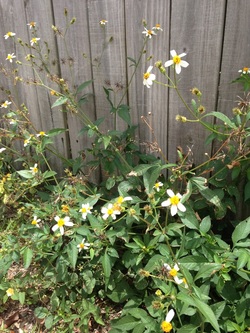
While pulling “weeds” earlier this week, I stopped to admire a nice patch of delicate white daisy-like petals dancing alongside several heads of annoying clinging needle-like spines. The Spanish Needle plant is revered by few but to many it’s considered annoying because it is very invasive, and the seeds (those needle-like spines) like to hitchhike on our socks, pants and pets, and poke you when you’re least aware. There are over 200 species in the world, and I swear it seems like they’ve all made their home in my garden.
TCM: Xian Feng Cao/Gui Zhen Cao
◦ Function: drain Damp; clear Heat & purge Fire
◦ Actions: reduce inflammation, clear Heat, remove toxicity & promote urination; invigorate Blood, dissipate Blood Stasis, reduce swelling, drain pus & generate flesh ; expel Wind-Heat; disperse Stasis, ease pain & treat cuts.
◦ Taste: sweet, bland, bitter
◦ Temperature: neutral
◦ Meridians: Kidney, Urinary Bladder, Small Intestine, Liver, Spleen, Large Intestine
◦ Caution/Contraindications: caution with Spleen & Stomach Deficient Cold; Contra in pregnancy!
(Source: www.AmericanDragon.com)
Having your way with Spanish Needle:
I’ll again remind you, when you’re harvesting any kind of “weed” for culinary use, be sure of your source - you don’t want to eat plants that have been sprayed with pesticides or are randomly growing along the roadside as they’re probably not going to be the healthiest or best choice. I have designated pots in my garden that I use to grow these medicinal/edible delights, and – like our ancestors – I always ask permission of the plant before picking, and thank them for their healing properties. With Spanish Needle in particular, it is not recommended to use too much of this plant raw as it contains saponin. I would also suggest using the younger leaves in your dishes, as they are a little bit more palatable; older ones tend to have a more bitter and astringent taste. For a delicious side dish, try boiling the leaves, drain, then sauté with olive oil, garlic and season to taste. Mix in a few of the younger leaves with your salad, and garnish with the petals scattered over the top for a yummy feast for the eyes. Bon appétit! Until next time, happy weeding, happy healing!
~~~~~~~~~~~~~~~~
* Disclaimer: This information is not intended to be a substitute for professional medical advice. You should not use this information to diagnose or treat a health problem or disease without consulting with a qualified healthcare provider. Please consult your healthcare provider with any questions or concerns you may have regarding your condition. The information provided is for educational purposes only and is not intended as diagnosis, treatment, or prescription of any kind. The decision to use, or not to use, any information is the sole responsibility of the reader.
References
Bensky, Dan et al. (2004). Chinese Herbal Medicine – Materia Medica. USA: Eastland Press Inc.
Foster, Steven & Hobbs, Christopher. (2002). Western Medicinal Plants and Herbs. NY: Houghton Mifflin Company.
Gurudas. (1998). The Spiritual Properties of Herbs. California: Cassandra Press
Heinerman, John. (1996). Heinerman’s Encyclopedia of Healing Herbs & Spices. NJ: Parker Publishing Company, Inc.
Jilin, Liu & Peck, Gordon. (2005). Chinese Dietary Therapy. Churchill Livingstone.
Ody, Penelope. (2000). The Chinese Herbal Cookbook – Healing Foods From East and West. Great Britain.
Pitchford, Paul. (2002). Healing With Whole Foods. California: North Atlantic Books.
Sgrol dkar skyabs & Rinchen dbang rgyal. (2009). Tibetan Herbal Legends. People’s Medical Publishing House.
Tierra, Michael & Tierra, Lesley. (1998). Chinese Traditional Herbal Medicine. USA: Twin Lakes.
Swerdlow, Joel. (2000). Nature’s Medicine: Plants That Heal. USA: National Geographic Society.
Warner, Monica. (2007). Herbal Plants of Jamaica. McMillan Publishers Ltd.
Yin-fang, Dai & Zhi-mei, Gong. (1987). Fruit as Medicine. Australia: Rams Skull Press.
Zhongbao, Zhu & Liu, Zhu. (2006). Chinese Herbal Legends. People’s Medical Publishing House.

 RSS Feed
RSS Feed
